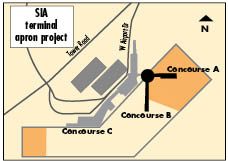Big airport apron project to cost far less
Savings, stimulus money could help SIA accelerate what was to be 10-year project

Savings of more than 50 percent on the first phase of a big project at Spokane International Airport to replace and expand an aircraft parking apron at the terminal, coupled with newly available funds from the federal government, could allow the airport to accelerate that multiyear project.
William Winkler Co., of Spokane, has made what appears to be the lowest bid for the first three phases of the project.
At $7.7 million, that contractor's bid was less than half the $15.7 million engineers had estimated those phases would cost, says airport spokesman Todd Woodard.
Overall, the apron replacement and expansion had been expected to cost up to $30 million, and was slated to take 10 years to complete, but those estimates are subject to modification because of the low initial bid, Woodard says.
The work is to include replacement of the concrete terminal parking ramp adjacent to concourses A and B, and construction of a new concrete apron on the west of the concourse C apron.
The project also includes reconstruction of a loading-dock area adjacent to concourse A.
Separately, SIA recently has secured $18 million in federal economic stimulus funding through the Federal Aviation Administration, $11 million of which is slated for the terminal apron project. The other $7 million is being set aside for two components of another planned airport project, in which SIA's main runway will be extended.
The airport currently is seeking bids for that project, and for a $6.4 million project to modify its parking lots to add 170 parking spaces and to track parking fees better with new software.
The Spokane Airports Board expects to award contracts for the terminal apron work and for the runway extension work at a special board meeting April 2, Woodard says.
The board will open bids for the runway project March 31.
Because of the highly competitive bids it has received for the apron project and the availability of the federal stimulus funding allocated for that work, the airport might accelerate the overall project's timeline and also reduce its overall cost by a third, he says.
Just how much the apron project's expected 10-year timeline could be reduced would depend on coordination with the FAA and the airlines that use the airport, Woodard says, adding that a lot of staging and communication must occur with major airlines before for such construction can take place.
"The phasing is really critical, because you're necessitating the airlines to change gates for a period of time," Woodard says.
He says airport infrastructure projects throughout the region stand to benefit from economic stimulus funding and from strong competition among contractors for bids this year.
"In talking to the FAA, this has been a pattern across the mountain states," Woodard says. "Projects are coming in startlingly below estimates."
Altogether, SIA has about $53 million in projects planned at the airport this year, and another $50 million in projects slated for 2010.
Related Articles




